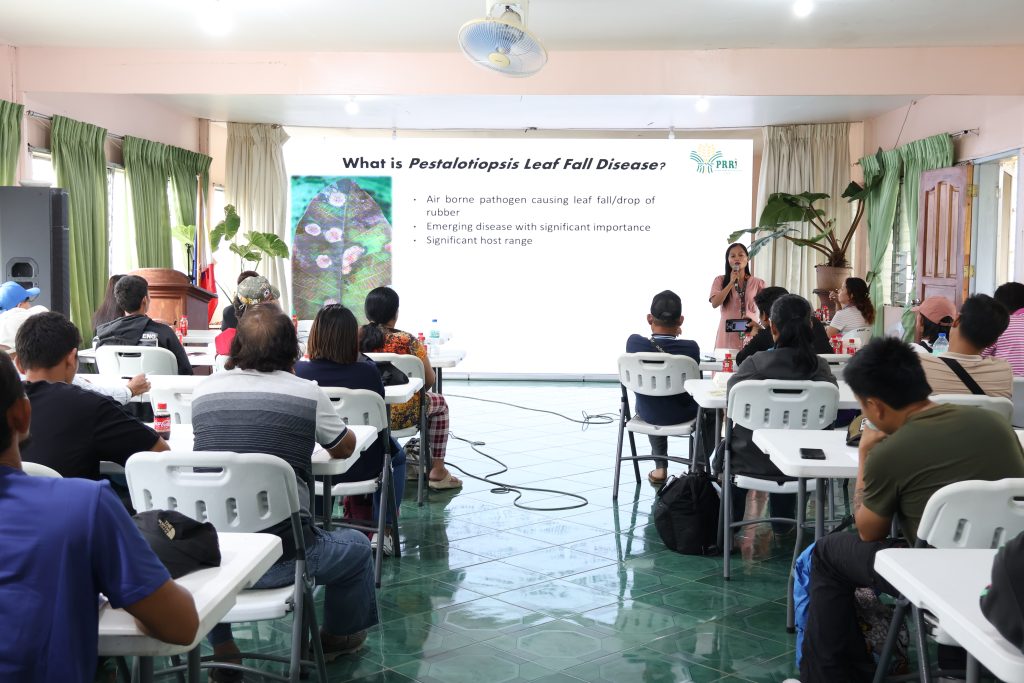
AEWS and rubber farmers from Bukidnon and Misamis Oriental undergo a training on rubber production with emphasis on PLFD.
MALAYBALAY CITY, BUKIDNON – To ensure a sustainable rubber industry, the Department of Agriculture – Regional Field Office 10 (DA-RFO 10) through its Regional Executive Director Carlene C. Collado, hosts training on Rubber Production and Pest Management on Pestalotiopsis Leaf Fall Disease (PLFD) at the Northern Mindanao Agricultural Crops and Livestock Research Complex in Dalwangan, here.
On March 21-22, 29 Agricultural Extension Workers (AEWs) and 21 rubber farmers attended the training from the provinces of Bukidnon and Misamis Oriental, which aims to educate them to adopt new technologies in rubber production, especially in determining the effective control measures for PLFD, among others.
With recently validated PLFD sightings in some parts of MisOr and Bukidnon, Director Collado emphasized that the capabuild will equip them to maximize rubber yield with an emphasis on adopting sustainable farming practices to ensure the industry’s long-term viability.
Philippine Rubber Research Institute Senior Science Research Specialist Jill D. Villanueva, PhD explained that PLFD is an airborne pathogen causing leaf fall of rubber caused by Pestalotiopsis sp., which affects a plant’s productivity by 30-90%.
Likewise, Dr. Villanueva tackled the prevalence of PLFD on rubber, proper management and its surveillance, while PRRI Science Research Analyst Ronie A. Magdua discussed the establishment and management of rubber nurseries.
To curb the production challenges of rubber, according to Lucille T. Minguez, DA-10’s Regional Crop Protection Center (RCPC) chief, the center increases its surveillance to find new cases, helps farmers with technical support, and campaigns for the use of fertilizers and the adoption of other Good Agricultural Practices (GAP) among rubber farmers.
She added that RCPC is also increasing its production of biological control agents (Trichoderma harzianum) and improving pest diagnosis to correctly identify PLFD, while involving rubber producers, the local government units, and other relevant stakeholders in the process.
Reyzel A. Matawhay, Agriculturist II of the Bureau of Plant Industry – Plant Quarantine Services also underscored their office’s directive for border control and safe agricultural trade, which prohibits the movement and carrying of plant parts and planting materials made of rubber from infected to non-infected areas.
Lemuel Aldin T. Yongco, a rubber technician of Impasug-ong town, expressed his gratitude for the opportunity to be part of the training, adding that his learnings will assist his fellow rubber farmers and the 500-hectare rubber plantation in their community.
“Thankful kaayo ko kay kini nga training usa ka dako nga oportunidad para sa amoa, daghan ko og nakutlo nga pagtulon-an, especially on how to do preventive measures.” he remarked.
Said activity was spearheaded by DA-10’s Various Production Support Services with its focal person Marnelly Ann P. Flores.# (MPMT)
